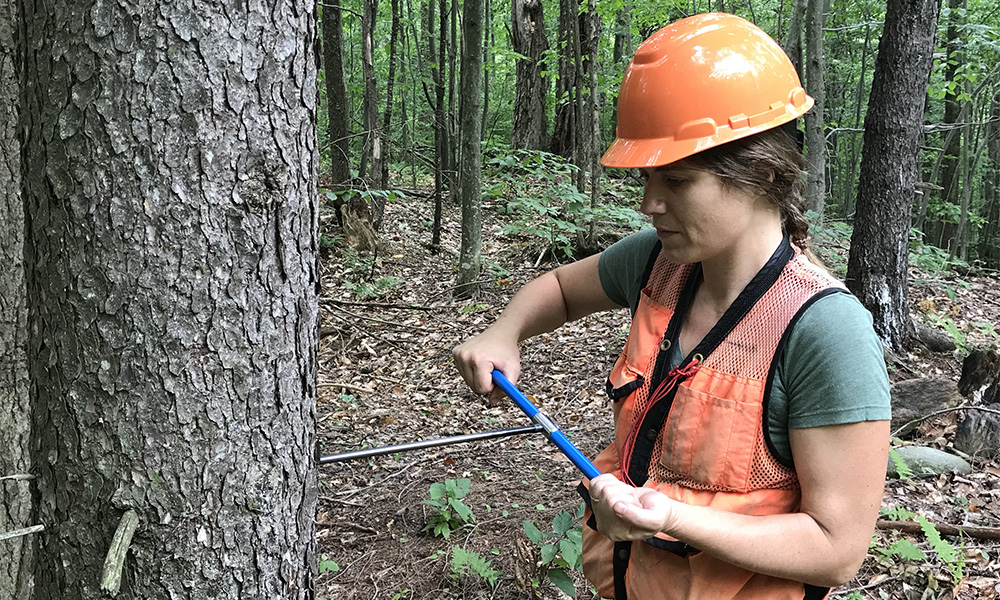First Comprehensive Open-Source Data Repository for Tree-Ring Ecological Data
Apr. 24th 2020Ecological researchers collect tree ring samples, or cores, using an increment borer to hand drill into a tree’s trunk and withdraw a pencil-sized column of wood containing the tree’s rings. Scientists count and measure rings to reconstruct the history of natural disturbances to old-growth forests, to study the extent to which climate and acidic deposition have driven recent tree growth patterns, and to assess factors that may contribute to tree decline.
Tree-ring and associated ecological data are the core of many forest ecology and management studies; however, until now these data were not readily accessible or systematically managed. Vermont researchers created The DendroEcological Network (DEN) as a centralized database to host these data, the first and only comprehensive database to date. The team developed the DEN as an open-source, web-based repository to store, share, access, and contribute dendrochronological (tree-ring records) and associated ecological data (e.g., site description, sampling plot and protocol, tree stem diameter and height).
Released in 2018 by the Forest Ecosystem Monitoring Cooperative (FEMC), a partnership of northeastern state natural resource agencies, the University of Vermont, and the USDA Forest Service, the DEN provides a comprehensive interface where individuals and scientific, conservation, and management communities can access and contribute dendrochronology and forest ecology data. Prior to the DEN, there was no singular, publicly available portal to collect and locate tree-ring records that also included key supplementary data, such as sampling protocols and tree stem diameters. If users desired ancillary data, they had to locate it by searching through the literature or by reaching out to individual laboratories to request the information. With the DEN, all of this data is included in one, online database, free and open for anyone to use.
The online repository is supported by a summary article published by James Duncan and Alexandra Kosiba of the FEMC and the University of Vermont, Shelly Rayback and Christopher Hansen also of the University of Vermont, and Paul Schaberg and Paula Murakami of the Forest Service. Rayback and Duncan, the primary contributors to the manuscript, detail the structure, content, and functionality of this tool in the context of forest ecosystem management.
With the recent release of this open-source database and a goal to standardize the storage, sharing, and accessibility of these key data for forest ecology, the authors ask the scientific community, forest ecologists, dendrochonologists, and forest managers to submit their data to the DEN.
Tree-ring data provide high-resolution information over large geographic scales about long-term forest growth and are widely used to understand ecological and environmental change. Having these data located in a centralized, open-source database is vital to expanding the scope of previous and future research. A central storehouse helps the research and management community to integrate analysis and exploration of these data among many partners, as the DEN brings together key data from multiple studies and geographic locations.
“By facilitating the preservation and sharing of data, the DEN will allow a large community of researchers to address important ecological questions at multiple temporal and spatial scales that cannot be answered by a single study alone,” says Rayback, Associate Professor of Geography at the University of Vermont and researcher of dendrochronology and climate change.
Though the repository is targeted toward the scientific and forest management communities to contribute data, any interested individual can access and explore the data for free. The web-based portal provides an interactive map of current research projects and data in the repository, enabling users to search by keyword, species, time range, or crown position (the vertical position of the tree in relation to surrounding trees). The DEN’s creators announce that a map to search by region will be available soon. The database currently houses data from seven states, primarily the northeastern United States but also including some sites in Ohio and Indiana.
This comprehensive repository provides the opportunity to collect and create more inclusive datasets and projects, enabling scientists and managers to gain access to high quality data from other studies and facilitating collaborative data investigation and analysis. In-depth descriptions and documentation of data models and other technical aspects of the tool can be found in the DEN Technical Report.
Currently, the DEN only accepts datasets that contain tree cores that were cross-dated. Individuals interested in contributing data should contact the FEMC team for assistance. A web-based interface for contributors to update and add data directly to the portal without assistance is in the works, with plans to be available in the near future. For now, those who wish to contribute data should contact FEMC staff either via this webform or by email at femc@uvm.edu.
Overall, this database provides resources for more integrated and inclusive scientific research. Hosting dendrochronological and forest ecology data in one place could allow for greater collaboration and investigation on pressing environmental issues, such as assessing the impact of winter injury on red spruce and subsequent reductions in carbon sequestration, or comparing responses to climate change between multiple tree species and influences of factors such as soil moisture on tree growth. An integrated database enables scientists and forest managers to work together more efficiently and effectively at both broad geographic scales and at the site level.
If you have questions about the DendroEcological Network or if you would like to contribute data to the portal, contact the FEMC team using this online form or email them at femc@uvm.edu.
 ecoNEWS VT
ecoNEWS VT